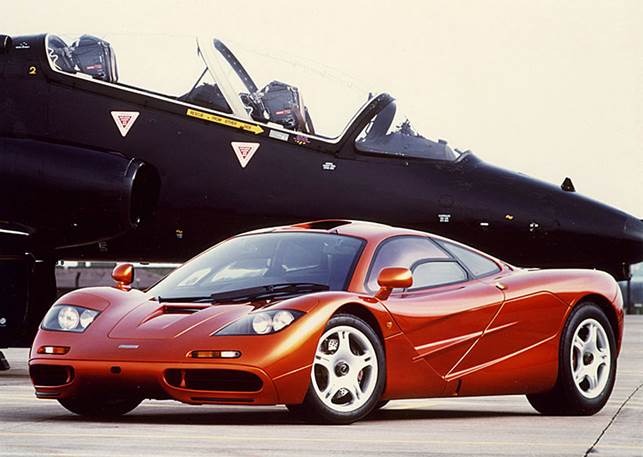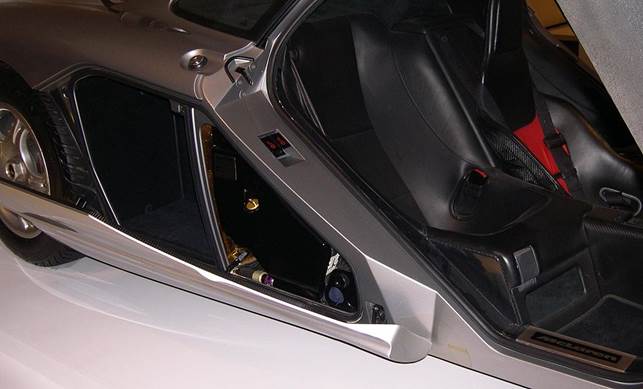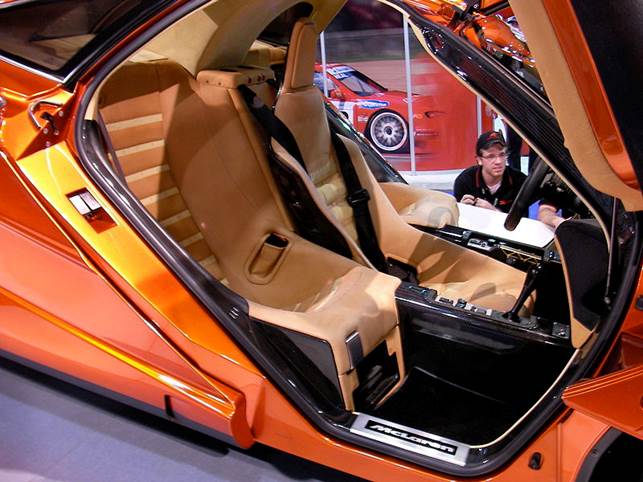Peter Stevens - The Designer
I’d worked with Gordon at Brabham Formula 1, and when the F1
project started, he asked if I knew a designer. I volunteered. Gordon doesn’t
see rules as being for him, so he’d question things. That culture grew into
everything we did. Gordon settled on the central seat with two people behind.
We made a mock-up, to ensure the car wouldn’t become large, that the windscreen
or side windows wouldn’t be horribly upright, and to see how you got in.

The F1 was the
first production car to use a carbon-fibre monocoque chassis
I deliberately didn’t draw anything for a year while we
sorted the packaging and where the engine and gearbox would be. Until you know
that, you’re just drawing for fun. So I made a large-scale wind-tunnel model,
which was very adjustable, before designing how it would look. It made everyone
comfortable because they realised I wasn’t a flakey stylist.
We knew we’d have two radiators, so there would be two front
intakes, and the air had to come out somewhere, so those kind of zoomy strakes
behind the front wheelarches came from what was needed, but you can draw bad
ones or nicer ones. We slaved over it, but I didn’t see it as work. The
detailing gets more complicated as you move rearwards because that’s where the
technical stuff is. The heat soak is enormous; the silencers get to 700degC.
All the numbers are enormous. For example, if you’re on the autobahn doing over
200mph and a truck pulls out half a km ahead, you’ll hit it; you can’t stop,
you’ve got to dodge it. It focuses you because you’re inviting someone to climb
in and it’s bloody quick.

1996 McLaren F1
side luggage compartment
Gordon wanted this car to be ‘analogue’, so you get little
messages when you’re going too fast… unless you’re a complete dickhead, but we
assumed those people wouldn’t have $995,253!
With the McLaren being the first full-carbon monocoque, it
was expensive, and we didn’t have any opportunity to change it once we’d tooled
up. It was hand-drawn, then the masters were made. Only the bits of glass
behind the passengers’ heads were done in CAD. McLaren couldn’t afford unique
taillights; they came from an Italian coach. TVR were using them, so all
homologation should’ve been done; but they’d never bothered!
We wanted some theatre when the doors opened, and had seen
some interesting angled-upwards doors on a Toyota show car. I’d also worked on
Porsche’s 962; I knew those doors stayed closed at 220mph, and you need a
strong roof for that, which we had. We made a little welding rod wire-frame
shape of the door and found a geometry that worked.
My favourite feature is the roof and the spine because
taking in air at the top was novel then, but making it look part of the design,
and making it structural in how it went down to the tail and had outlets… it’s
quite complicated, and I think the graphic of the holes and glazing works well.
Also, from the front when you open both doors there’s a curve across the
windscreen and up the side glass. It makes this big swoopy shape; I didn’t
design it to look like that, it was just an outcome.

The three seat
setup inside an F1.
Only one bit irritates me: the middle strake that comes from
the front wheel. It goes up across the door, almost gets to the rear wheelarch,
then makes this crappy little turn upwards.
Ron was extraordinary: he didn’t really know any of us on
the design team but he trusted us with his money, and until he saw the finished
car, he didn’t know what we’d been doing. He gave us 100% support, we had a
brilliant facility… great food! McLaren’s company culture is often criticised,
but from within the culture is very warm and friendly. It played a huge part in
making the F1 the car it is.’
|
Specs
Mc Laren F1
(1994-’98)
·
Price then $895,727.70
·
Engine : 6064cc 48v V12, 627bhp, 479lb ft
·
Transmission : Six-speed manual, rear-wheel drive
·
Performance : 3.2sec 0-60mph, 235mph
·
Weight/made from1140kg/carbonfibre
|